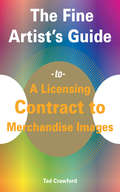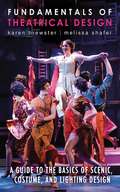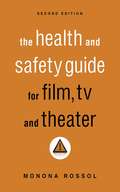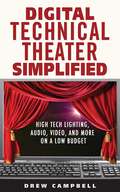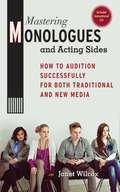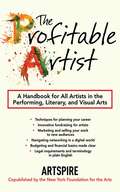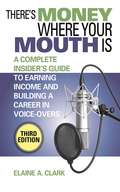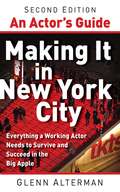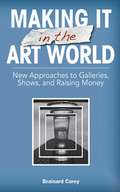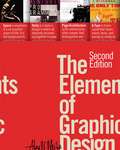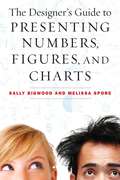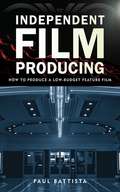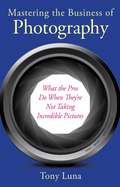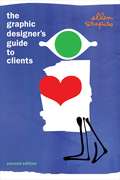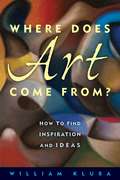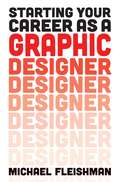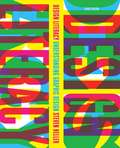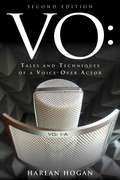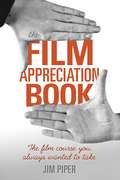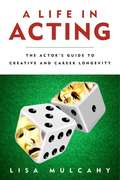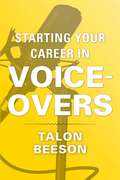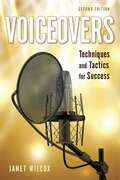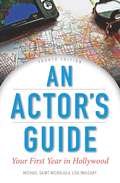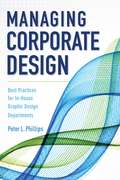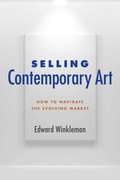- Table View
- List View
The Fine Artist's Guide to a License Contract to Merchandise Images
by Tad CrawfordPart of The Fine Artist's Guide to series, this classic guide includes information about the issues relevant to artists today. Granting others the rights to use images created by an artist for posters, calendars, greeting cards, stationery, apparel, wallpaper, mugs and other household items can be extremely lucrative. This guide details the appropriate steps an artist should take when interested in merchandising images and includes a sample contract and a negotiation checklist.
Fundamentals of Theatrical Design: A Guide to the Basics of Scenic, Costume, and Lighting Design
by Melissa Shafer Karen BrewsterVeteran theater designers Karen Brewster and Melissa Shafer have consulted with a broad range of seasoned theater industry professionals to provide an exhaustive guide full of sound advice and insight. With clear examples and hands-on exercises, Fundamentals of Theatrical Design illustrates the way in which the three major areas of theatrical design-scenery, costumes, and lighting-are intrinsically linked. Attractively priced for use as a classroom text, this is a comprehensive resource for all levels of designers and directors.
The Health & Safety Guide for Film, TV & Theater, Second Edition
by Monona RossolThis second edition has been expanded and updated to address new hazards, unique health and safety problems, and particular regulations that threaten anyone working in the entertainment industries today. Artists' advocate Monona Rossol exposes the hazards of theatrical paints, theatrical makeup, pigments, dyes, plastics, solvents, woodworking, welding, asbestos, fog, and offers practical solutions to these dangers. No one working in the performing arts can afford to skip this handbook packed with life-or-death health and safety information.
Digital Technical Theater Simplified: High Tech Lighting, Audio, Video and More on a Low Budget
by Drew CampbellThe theater is in the midst of a digital revolution! This book provides readers with an easy-to-understand overview of the digital technology currently available for the stage. In clear language, Digital Technical Theater Simplified explains digital technology in the fields of lighting, audio, video, and show control. All chapters contain do-it-yourself examples of how anyone can use these advanced technologies, as well as case studies of "How the Pros Do It."
Mastering Monologues and Acting Sides: How to Audition Successfully for Both Traditional and New Media
by Janet WilcoxMastering Monologues and Acting Sides: How to Audition Successfully for Both Traditional and New Media is everything an actor needs to be ready for that perfect part, from webisodes to Shakespeare. Scripts, acting technique tips, and exercises keep a performer toned and ready, while industry experts give advice on how to audition professionally. Invaluable Internet listings keep you on top of changing trends, as well. Casting directors, agents, managers, and actors share insights on proper protocol for different performance settings, and practice is made simple with script excerpts and exercises to keep skills sharp for last minute auditions. Includes instructional CD.
The Profitable Artist: A Handbook for All Artists in the Performing, Literary, and Visual Arts
by ArtspireWhile all art is unique, the challenges artists face are shared regardless of background, experience, and artistic medium. <P><P>With decades of experience training and helping artists, the expert staff of the New York Foundation for the Arts have compiled a "best practices" approach to planning and organizing an art career. In this book, NYFA has identified common problems, examined specialized areas of business, ?nance, marketing, and law, and distilled these topics in such a way that readers can digest them and apply them to their own experience and practice. Included are interviews, anecdotes, and in-depth case studies. The skills and guidelines in The Pro?table Artist will also translate effectively to teaching and mentoring opportunities that artists may encounter as their career progresses. This invaluable guide appeals to all artists in all disciplines of the literary, media, performing, and visual arts, from recent art school graduates to established artists undertaking new arts businesses to artists seeking more from their careers at any stage of their career.
There's Money Where Your Mouth Is: A Complete Insider's Guide to Earning Income and Building a Career in Voice-Overs
by Elaine A. ClarkVoices are increasingly in demand for commercials, cartoon characters, announcements, and other spots. This outstanding handbook explains how to launch a career and ?nd work. Along with sample commercials and script copy, the author gives advice on vocal exercises, self-promotion, and business matters. Chapters include: getting started, voice-over aerobics, copy basics, melody and tempo, layering techniques, believing what you say, commercial and stylized characters, corporate narration, animation, video games and toys, getting an agent, marketing your talent, and staying on top of the business. This expanded edition features new tips on making a demo CD, vocal modulation and breath techniques, advanced copy-reading strategies, and a section on how copywriters see the job of the voice artists for whom they write. If you've ever been interested in voice-over acting, you need this book!
An Actor's Guide--Making It in New York City: Everything a Working Actor Needs to Survive and Succeed in the Big Apple
by Glenn AltermanFor any actor in or on the way to New York City, this is the definitive source for advice, winning strategies, marketing techniques, and invaluable insights to being a successful New York actor. This new edition has been completely revised and updated to cover the significant changes in the New York theater landscape over the last nine years. This indispensable guide has also been expanded to include dozens of new interviews with top New York City actors and a completely improved Internet chapter equipped with the most up-to-date tools to thrive in the industry. Aspiring and established professionals will find this thorough and up-to-the-minute volume chock full of resources and advice about auditioning, making professional connections, promoting one's self, seeking opportunities in nontraditional venues, finding an apartment, securing "survival jobs," understanding actor unions, getting headshots, and furthering one's actor training in New York. This guide also details working as a film extra, careers in print modeling, scams and rip-offs to avoid, opportunities for actors with disabilities, and using the Internet to the fullest advantage. Included are in-depth interviews with legendary show business figures such as actor Henry Winkler, casting director Juliet Taylor, and theater director Joseph Chaikin as well as top talents from the fields of film, television, stage, commercials, and talent agencies. Written by a professional New York actor with over thirty years of experience, this meticulously researched guide will give actors the tools they need to survive and thrive in New York show business.
Making It in the Art World: New Approaches to Galleries, Shows, and Raising Money
by Brainard CareyLearn how today's artists survive, exhibit, and earn money, without selling out! This book explains how to be a professional artist and new methods to define and realize what success means. Whether you're a beginner, a student, or a career artist looking to be in the best museum shows, this book provides ways of advancing your plans on any level. Making It in the Art World is an invaluable resource for artists at every stage, offering readers a plethora of strategies and helpful tips to plan and execute a successful artistic career. Topics include how to evaluate your own work, how to submit art, how to present work to the public, how to avoid distractions in the studio, and much more.
The Elements of Graphic Design
by Alex W. WhiteThis very popular design book has been wholly revised and expanded to feature a new dimension of inspiring and counterintuitive ideas to thinking about graphic design relationships. The Elements of Graphic Design, Second Edition is now in full color in a larger, 8 x 10-inch trim size, and contains 40 percent more content and over 750 images to enhance and better clarify the concepts in this thought-provoking resource. The second edition also includes a new section on Web design; new discussions of modularity, framing, motion and time, rules of randomness, and numerous quotes supported by images and biographies. This pioneering work provides designers, art directors, and students--regardless of experience--with a unique approach to successful design. Veteran designer and educator Alex. W. White has assembled a wealth of information and examples in his exploration of what makes visual design stunning and easy to read. Readers will discover White's four elements of graphic design, including how to: define and reveal dominant images, words, and concepts; use scale, color, and position to guide the viewer through levels of importance; employ white space as a significant component of design and not merely as background; and use display and text type for maximum comprehension and value to the reader. Offering a new way to think about and use the four design elements, this book is certain to inspire better design.
The Designer's Guide to Presenting Numbers, Figures, and Charts
by Sally Bigwood Melissa SporeNumbers can tell an exciting story. The trick is to know what story to tell and make it understandable. This compact, practical guide will show everyone who must design numeric data how to transform raw data into readable, relevant information.The Designer's Guide to Presenting Numbers, Figures, and Charts brings together the guidelines established over the last forty years for making effective presentations of figures, tables, and graphs. Included are the straightforward steps designers and other professionals can take to make their tables and charts the most meaningful. The authors define and discuss a range of graph types, from simple bar and pie charts to contemporary "data visualizations," offering explanations of the intended application of each. Readers will learn when to use a table, when to use a chart, which chart is best to use, and how to make all numeric presentations as comprehensible as possible. Specific topics include: Rounding numbersTable constructionChart designGuidance on numbers and page layout Color Reference and demonstration tablesPresenting figures in PowerPointOrdering numbers for decision-makingMultiple comparisonsGridsAnd more Communicating information effectively is an increasingly important skill in the digital age. People find numbers persuasive, and well-executed visual presentations of information will influence more people and even shorten meetings. Complete with a glossary and helpful exercises, this guide offers everything needed to create more-effective presentations.
Independent Film Producing: How to Produce a Low-Budget Feature Film
by Paul BattistaThe number of independent films produced each year has almost doubled in the past decade, yet only a fraction will succeed. If, like many filmmakers, you have no industry connections, little to no experience, and a low or ultra-low budget, this outsider's guide will teach you what you need to know to produce a standout, high-quality film and get it into the right hands. Written by an entertainment lawyer and experienced director and producer, this handbook covers all the most essential business, legal, and practical aspects of producing on a low budget, including:Scripts Business plansCopyright issuesEquity and non-equity financingFund-raisingTax considerationsTalent recruitingSchedulingDistribution Securities laws Film festivals And more Also discussed are the new crowd funding laws covered by the JOBS Act, making this book a must-read for every indie producer in today's economy. If you want to produce a film that gets attention, pick up the book that is recommended or required reading at film, business, and law schools from UCLA to NYU. Whether you're a recent film school graduate or simply a Hollywood outsider, Independent Film Producing will be like having a best friend who is an experienced, well-connected insider.
Mastering the Business of Photography: What the Pros Do When They're Not Taking Incredible Pictures
by Tony LunaPhotography can be a competitive and unforgiving trade, however there are many strategies for professional success. This book is a resource for photographers of all kinds and demonstrates the many ways to manage a career in photography, while still "earning enough money to support yourself, a family, your interests, your aspirations, and your passion." Mastering the Business of Photography offers insights into what happens when you're not shooting-which is most of the time-and explains what you must do to further your career, make a living, and accomplish your personal goals. Topics include: Organizing assignments from start to finish Creating a plan and calculating risks Building a standout portfolio Anticipating financial matters Working with clients Self-promoting Getting paid Booking gigs Negotiating a contract And much moreFor freelance photographers and for those employed by agencies as well, this guide is full of practical advice for navigating the world of photo work, coming from an industry professional with over forty years of experience.
The Graphic Designer's Guide to Clients: How To Make Clients Happy And Do Great Work
by Ellen M. ShapiroHere is the perfect volume for graphic designers who want real-life advice for long-term success. Renowned designer Ellen Shapiro reveals time-tested tricks of the trade-for making sure the clients you want to work with know about you, become your clients, and work with you productively. Then, in a series of one-on-one interviews, leading designers such as Milton Glaser, April Greiman, Mke Weymouth, Drew Hodges, Marc Gobé, and partners in Pentagram reveal their personal experiences and insights on how to uphold creative standards while fulfilling clients' needs. Their advice will help you:Identify what is distinct about your services Market yourself effectively Meet and court clients Learn the lingo of corporate strategy Make effective presentations Believe in the work you do and sell the work you believe in Obtain referrals from existing clients Keep clients coming back for moreCEOs and design managers from nineteen marketing and design-savvy clients-such as Klein Bikes, The Knoll Group, Barnes & Noble, and Harvard University-offer their own candid perspectives on the challenges solutions, and triumphs of working with designers. Whether you are courting your first clients or seeking fresh insights for achieving even greater success, you cannot afford to be without this crucial resource.
Where Does Art Come From?: How to Find Inspiration and Ideas
by William KlubaWilliam Kluba, author, takes an in-depth look at the origins of inspiration and ideas, to help us better understand where creativity comes from in our bodies and minds, and to understand how this intangible force translates into artistic expression. This book is full of techniques to foster the inspiration behind artistic work and to utilize the creative process. Where Does Art Come From? not only provides a resourceful guide for aspiring and professional artists, it presents an entire way of life that will transform the way you approach each and every day.
Starting Your Career as a Graphic Designer: Revised Edition (Starting Your Career)
by Michael FleishmanThe ultimate source for beginning professionals, working professionals looking to make a change, and entrepreneurs wanting to go out on their own, this friendly guide details every business aspect of commercial graphic design, including how to: Create a portfolio Make initial contacts Develop a financial plan Set up an office Acquire supplies and equipment Price your own work Market on the Web Nurture a growing freelance business And much moreIn a market-by-market survey, the author devotes entire chapters to selling one's work within every venue, including magazines, ad agencies, book publishers, greeting card companies, small business, and Web sites. This is the most useful book on the market for honing the business skills of freelance illustrators and graphic designers.
Design Literacy: Understanding Graphic Design
by Rick Poynor Steven HellerAuthor and design expert Steven Heller has revisited and revised the popular classic Design Literacy by revising many of the thoughtful essays from the original and mixing in thirty-two new works. Each essay offers a taste of the aesthetic, political, historical, and personal issues that have engaged designers from the late nineteenth century to the present--from the ubiquitous (the swastika, antiwar posters) to the whimsical (MAD magazine parodies). The essays are organized into eight thematic categories--persuasion, mass media, language, identity, information, iconography, style, and commerce.This revised edition also highlights recent trends in graphic design such as aesthetic changes in typography in the digital age and the nexus between graphic design and wired culture. This is an eclectic look at how, why, and if graphic design influences our ever-evolving, diverse world.
VO: Tales and Techniques of a Voice-Over Actor
by Harlan HoganOne of the country's top voice-over talents shares his secrets of success in an insider's guide to the industry. Actors, broadcasters, and anyone who has longed to earn a living by speaking into a microphone will cherish this insightful and often hilarious glimpse at the business. Coverage includes: Identifying natural talent Training a voice to make it commercially viable Gaining experience in smaller markets Making a demo CD Auditioning effectively Locating and signing with an agent Joining the appropriate unions Negotiating contracts Self-promoting to maximize exposureReflecting the quantum change that has occurred in the way voice-overs are recorded and cast in recent years, the updated Second Edition describes the advantages and disadvantages of auditioning and recording from home studios for clients around the world. This indispensable guide also addresses finding work in venues outside film and television, such as games, automated telephone systems, and websites. Aspiring and established voice-over actors will savor the behind-the-scenes details that show what actually happens during a voice-over recording session. Through it all, the author pairs performance tips with an expanded personal account of the crazed clients, practical jokes, and coincidences encountered on the long journey to success.
The Film Appreciation Book: The Film Course You Always Wanted to Take
by Jim PiperThis is a book for cinephiles, pure and simple. Author and filmmaker, Jim Piper, shares his vast knowledge of film and analyzes the most striking components of the best movies ever made. From directing to cinematography, from editing and music to symbolism and plot development, The Film Appreciation Book covers hundreds of the greatest works in cinema, combining history, technical knowledge, and the art of enjoyment to explain why some movies have become the most treasured and entertaining works ever available to the public, and why these movies continue to amaze viewers after decades of notoriety.Read about such classic cinematic masterpieces as Citizen Kane, Gandhi, Midnight Cowboy, Easy Rider, True Grit, Gone With the Wind, and The Wizard of Oz, as well as more recent accomplishments in feature films, such as Requiem for a Dream, Munich, The King's Speech, and The Hurt Locker.Piper breaks down his analysis for you and points out aspects of production that movie-lovers (even the devoted ones) would never recognize on their own. This book will endlessly fascinate, and by the time you get to the last chapter, you're ready to start all over again. In-depth analysis and thoughtful and wide-ranging film choices from every period of cinema history will ensure that you never tire of this reading companion to film.
A Life in Acting: The Actor's Guide to Creative and Career Longevity
by Lisa MulcahyA Life in Acting is a practical guide for aspiring and established theater actors looking to make a consistent living doing meaningful, creative work on the stage. Author Lisa Mulcahy communicates her advice through a series of interviews and "war stories" that will have you taking notes and laughing until your sides hurt. The sage advice of veteran performers and an entertaining writing style make this a terrific tool to build career longevity. The veteran thespians who give advice are and sustain themselves as artists and professionals through the sage advice of veteran performers who have already done it and continue to do so. Each industry veteran who contributes to these pages is renowned for their talent, is vastly respected by their peers, and has worked consistently in the theater for decades. Actors will learn how some of the industry's most successful and longest-surviving members have developed invaluable traits that have kept them in show business, including: Recognizing personal strengths Developing versatility Marketing oneself effectively Earning a paycheck Pursuing the most valuable opportunities Choosing the right kind of training Finding a mentor Making important connections Dealing with success and failure And much moreA Life in Acting is a must-read for career stage actors. It is a book that will serve as the ultimate guide that can be referenced again and again. Learn how the best actors in the business have made their built a life on the stage, and how you can too!
Starting Your Career in Voice-Overs (Starting Your Career)
by Talon BeesonVoice-over acting is no longer all about having that "announcer-y" boom or classic fireside radio voice. More and more casting directors are looking for regular, "conversational" voices to represent a product in a commercial or to play the animated moose in a new Hollywood flick, but the competition is fiercer now than ever before. In a business that is "more risk than reward, more heartbreak than success," author Talon Beeson will show you in Starting Your Career in Voice-Overs how to beat the odds, improve your skills, make the right connections, and build a career in the voice-over business. Some of the topics covered in this book include:Warm-up exercises for the voiceReading everything-jokes, telephone numbers, video games, commercials, feature films, and moreCold readsAnalyzing scenes and translating that analysis to voiceCreating demo tapesRepresenting and marketing yourself effectivelyEquipment and recording at homeAnd many more!This instructional book for professionals presents readers with varying techniques, exercises, and theories to practice-a vocational foundation guaranteed to elevate an actor's game. In an ingenious and instructive way, Beeson relates voice work to the greatest dramatist of all times, William Shakespeare. This is an added bonus for the classically inclined individual and provides excellent training for every actor. This intellectually informed book is designed improve your voice skills and teach you the basics of the business-the ultimate preparation for any serious actor seeking to pursue this field. Surrounded by microphones, voice-over actors are a unique breed who require additional and different skills to create their reality, and Talon Beeson shows you how to do just that in Starting Your Career in Voice-Overs.
Voiceovers: Techniques and Tactics for Success
by Janet WilcoxHave you ever been told that you have a great voice? Put it to use in a career as a voiceover actor! Veteran voice-over actor, writer, producer, and teacher Janet Wilcox provides the inside scoop on the industry and personal training to help voice-over hopefuls find work in network promos, commercials, documentaries, books on tape, radio, animated films, and more! This rich resource comes with a CD-ROM featuring vocal exercises and interviews with voice-over actors. Readers will discover a treasure trove of useful information, including:Acting warm-ups Vocal workouts Improv sketches Character work sheets Tips for making demos Sample V.O. scripts Interviews with show biz heavyweights Casting insights Advice on getting professional representation Secrets to finding opportunities in traditional and emerging venues And much more!Voiceovers, Second Edition shows readers how to use that great voice to garner cash and compliments.
Actor's Guide: Your First Year in Hollywood
by Lisa Mulcahy Michael St. NicolasFor every actor beginning a career in Hollywood, this indispensable guide will lay out a clear and comprehensible path with tried-and-true advice. Up-to-date resources and new interviews with recently established actors experiencing the current movieland scene--as well as the timeless voices of established actors and industry pros--make this a rich compendium of Hollywood know-how. Delve into the industry with the support from An Actor’s Guide: Your First Year in Hollywood and discover with confidence how to: Find work through a variety of sources Deliver stunning auditions Join SAG-AFTRA Get a great headshot and put together a stunning resume Build your credentials and gain exposure Hone your craft with professional training and classes Snag a top-notch agent Utilize the power of social media From settling into Los Angeles and sticking to a tight budget, to adventures in reality TV and landing the breakthrough parts you came to Hollywood for, any actor eager to learn will get his or her fair share of insider knowledge with this manual and will discover how to create a positive experience while launching an exciting career.
Managing Corporate Design: Best Practices for In-House Graphic Design Departments
by Peter L. PhillipsCorporations increasingly view graphic design as a core strategic business competency in a highly competitive climate, and they are challenging their in-house designers to supply far more than a service or support function. Their new role is to provide sound solutions to real-world business pressures. Managing Corporate Design addresses--head-on--these new challenges in a highly practical manner. Peter L. Phillips writes specifically to corporate in-house graphic design groups searching for positive, accessible methods to better establish their group as a core strategic business competency. This guide covers: Developing a framework Assessing the value you offer Recognizing the business role of design Communicating in a corporate language Gaining and forming business relationships Developing design briefs and approval presentations Managing and hiring staff Incorporating creativity Overcoming obstacles and moving forward! These fresh strategies and more provide actionable tools for helping corporate design teams meet the new business demands of today.
Selling Contemporary Art: How to Navigate the Evolving Market
by Edward WinklemanA sophisticated examination of today’s contemporary art market from an art dealer’s point of view, this new book focuses on recent changes in the quickly evolving market. With an emphasis on how the market responded to the global recession that began in 2008, gallery owner Edward Winkleman moves from an examination of the factors beyond the individual dealer’s command to those that the dealer can control. Sections cover: The rise of the art fair The rise of the mega gallery New online competition Models of post-brick-and-mortar art dealing Art dealers as art fair organizers Collaboration in a new era Coverage is also given to the specifics of contracts contemporary art dealers may need, including an examination of a variety of contracts for representation, consignment, and new forms of contemporary art. Exhibiting a wide range of interviews with international experts including dealers, collectors, art-fair directors, journalists, and online art entrepreneurs, Selling Contemporary Art is a must-read for gallery owners, dealers, and artists affected by the rapid innovations in the art-dealing industry.
